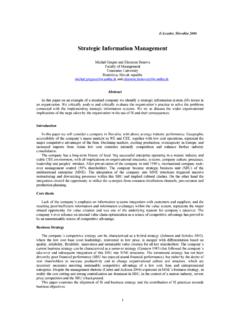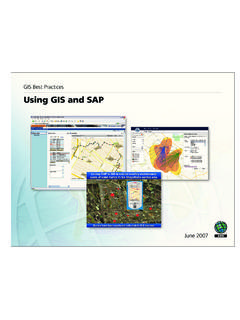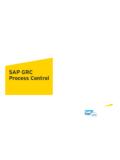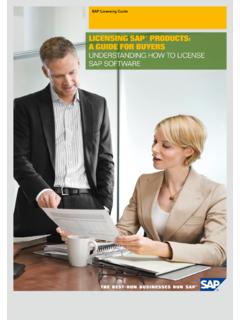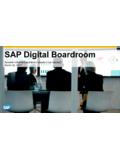Transcription of Best Practices in the Procure-to-Pay Cycle: …
1 9 PRACTIX | Best Practices in the Procure-to-Pay Cycle | CAPS | March 2006 VOLUMEMARCH2006 Best Practices in the Procure-to-Pay Cycle: Perspectives from Suppliers and Industry Experts Rob Handfield, Bank of America University Distinguished Professor,North Carolina State UniversityExecutive SummaryA benchmarking study of the Procure-to-Pay (P2P) process was carried out with anumber of suppliers and subject matterexperts. The research identified six keyfindings that can lead to improvement inthe P2P cycle: Robust processes and training Onsite relationship managers toallow field maintenance to focus on doing its job Robust technology using single point of contact, , supplier portal Improved forecasting formaintenance and planning foremergencies that can flex withdifferent situations that arise Reduced complexity in catalogsand buying channels to streamline procurement Top management supportIn addition, a suggested approach forimprovement of the P2P was developedthat involved securing top managementsupport.
2 Mapping processes,understanding needs of user groups,running team redesign workshops,exploring technology solutions, definingthe new process, training users, andupdating the system over technology and business requirementsevolve, the P2P cycle will probably needto be revisited from time to time toensure it is meeting the needs of internalcustomers and that suppliers aresatisfied with the is available ONLY (and at no charge) receive automatic notification of issue availability, send an e-mail to Debbie along with your name and e-mail companies are seeking to move beyondprocurement into fully deployed supply chainsystems, a key challenge for many of them is in the area of improving efficiency in theirprocure-to-pay cycles for many of theircontracted services, especially in the area offacilities maintenance and onsite contractmanagement.
3 There exist multiple challenges in environments where field associates areworking from manual or electronic systems,requisitioning onsite services for maintenance orother activities, and ensuring that thisinformation is captured effectively. In addition,there exist significant challenges to ensure thatthe proper service level agreement is fulfilled,the correct price is charged, the purchase order istransmitted correctly, the invoice matches, andfinally, that the supplier is paid the correctamount for the actual services delivered.
4 While many enterprise systems claim that these elements are simply defined within their structural logic, the truth is that there aremany opportunities for error, and that without aplanned process for managing the Procure-to-Pay cycle, the organization may be bearingsignificant costs due to non-compliance tosystem or process benchmarking study sought to define andunderstand the best Practices currently beingemployed by companies in the procure -to-paycycle for services. Specifically, the researchteam focused on learning and sharing bestpractices in the following areas, shown in Figure 1.
5 Forecasting and Planning of Requirements Need Clarification/Specification Sourcing Decisions in Emergency/Non-Emergency Situations Contract PO Generation for Structured or Unstructured Requirements Receiving of Services, Materials, and Documents Settlement and Payment in Accounts PayablePRACTIX | Best Practices in the Procure-to-Pay Cycle | CAPS | March 20062 Procure-to-Pay CyclePROCURE-TO-PAYG eneric High-Level Process MapPROJECTSSTARTF orecastPlan &CoordinateNeedClarification/Specificati onSourcingDecisionContract/ POGenerationReceiveMaterial &DocumentsSupplierNeedFulfillmentSettle &PayMAINTENANCEOPERATIONSENDE nablers: Finance, Legal, HR, ITFigure 1.
6 procure -to-PayGeneric High-Level Process MapPRACTIX | Best Practices in the Procure-to-Pay Cycle | CAPS | March 20063 Procure-to-Pay CycleSymptoms and Root Causes: ASupplier s View of the P2P ProcessResearchers first began by identifying the truecustomer of the P2P process: the supplier whowishes its invoice to be paid quickly. Manyorganizations are seeking to build and extendrelational capital with suppliers by building trustand becoming the customer of choice. Thecapital gained through this approach can resultin preferred supplier delivery priorities,information sharing, participation on suppliercouncils, and other important rewards.
7 Animportant element in becoming a customer ofchoice is to enable rapid payment and equitableand ethical treatment of suppliers. To address some of the major problemsidentified by suppliers, researchers scheduled a series of interviews with a group of suppliers,to identify their experiences with the currentprocure-to-pay process with some of their major shown in Figure 2, the most commonsymptoms experienced by suppliers involve high manual workarounds required to addressproblems, long cycle times for payment, nocentral point of contact, and a problem withmatching the PO and invoice.
8 Some of thetypical responses from suppliers in thesecategories involved having to contact accountspayable multiple times, having to re-submitinvoices, and waiting 90 or more days in somecases for CausesSuppliers interviewed also noted a number ofroot causes associated with the P2P shown in Figure 3, the most common rootcauses were associated with the lack of aformally designed P2P process, the lack of acentral relationship management, or problemsassociated with supplier interfaces with reasons included the increased complexityassociated with SAP catalog and line items, andthe lack of a forecasting can be seen from these examples thefundamental root causes are 1) a lack of a process with designated roles and 2) specificprocesses associated with different internal andexternal functions are not defined.
9 Maintenancepeople, buyers, planners, schedulers, accountspayable, project planners, and others are not in sync. Further, the system is not designed tobe able to withstand the various approaches in which people are entering data and requestinginformation. When too many people are notusing the system in a unified manner, it is nowonder that the system rejects the input andcauses problems. This indicates that either thetolerances of such systems must be changed, or that the manner in which the system is usedmust be FREQUENCY OF RESPONSESI ssue/Opportuntiy Manual workarounds and high manpowerLong cycle time/Late payments/Aged invoicesNo central point of contactPO/Invoice match problemNot enough funds on POEmergency work never properly recordedTOTAL765543 ROOT CAUSEFREQUENCY OF RESPONSESI ssue Poorly designed process No relationship manager/point of contactLack of system/portal interfaceToo much complexity in SAP catalog/line itemsNo forecast or plan in placeToo many suppliers drive
10 ComplexityTOTAL865541 Figure 2:Symptoms Identified by SuppliersFigure 3:Root Causes Identified by SuppliersPRACTIX | Best Practices in the Procure-to-Pay Cycle | CAPS | March 2006 Procure-to-Pay Cycle4 Recommended SolutionsThese same set of issues were identified inrecommended solutions suggested by suppliers recommended that their customersexplore the solutions shown in Figure top four elements that were identified aspossible solutions included redesigning the P2 Pprocess, developing a dedicated relationshipmanager to work with suppliers on key areas of interface.


